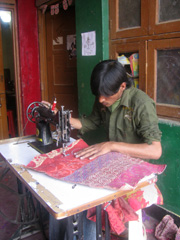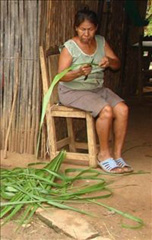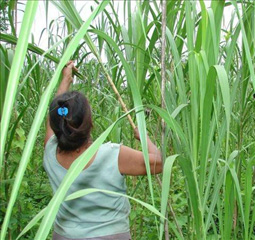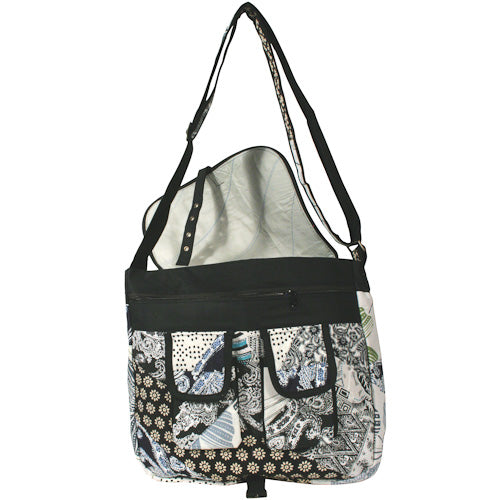OWP
Patchwork Messenger Bag
Patchwork Messenger Bag
Couldn't load pickup availability
Multiple pockets, magnetic button closers and an adjustable strap, these are some of the many features of this recycled messenger bag. These bags are made from re-purposed fabrics. Sorted into like and complimentary colors, the patches are joined together to create these durable and cool bags, perfect for work or school!
These bags are handmade by the youth at Lakshya shelter home in Faridabad, India. Lakshya primarily supports children and youth who have run away from their homes. Lakshya, sends the younger children to local schooling facilities, and the youth are given vocational trainings to help earn a living and support themselves. Buy these unique products and support Lakshya's objective of providing better facilities to these children.
- Measures 13” high x 15-1/4” wide x 3” deep
- Outer flap comes with a buckle closer
- 2 outside pockets and several inside pockets
- 14"-29" adjustable strap
Handmade in India and fair trade imported.
Lakshya, is a child and youth rehabilitation center located in a small village Bhatola, Faridabad, a few miles from Delhi. Lakshya was founded in 2004 by two brothers, Rajeev and Umesh; they started by training a few village women in making newspaper bags. The village women grew from 8 to 150 over the years, and today make newspaper and other paper packaging bags which are supplied to several stores in India.
 Rajeev and Umesh were part of a larger youth rehabilitaion programe, Karm Marg in New-Delhi. They began their own initiative by the name of “Lakshya”, meaning goal. With the support of the Salam Balak Trust, a well known children and youth rehabilitation center, Lakshya currently runs a center in the village. Many youth and children, who have either runaway from homes or orphaned are found at public places such as railway stations and bus stands. Lakshya's network of people, who closely monitor these locations and keep a regular contact with the local police, bring these youth and children to the shelter. In some cases, parents or relatives are contacted and the children are sent back, in other cases they stay at the shelter for sometime and escape again, while some stay on. Currently, Lakshya supports a mixed group of 25 youth and children in the age group of 7-25 years.
Rajeev and Umesh were part of a larger youth rehabilitaion programe, Karm Marg in New-Delhi. They began their own initiative by the name of “Lakshya”, meaning goal. With the support of the Salam Balak Trust, a well known children and youth rehabilitation center, Lakshya currently runs a center in the village. Many youth and children, who have either runaway from homes or orphaned are found at public places such as railway stations and bus stands. Lakshya's network of people, who closely monitor these locations and keep a regular contact with the local police, bring these youth and children to the shelter. In some cases, parents or relatives are contacted and the children are sent back, in other cases they stay at the shelter for sometime and escape again, while some stay on. Currently, Lakshya supports a mixed group of 25 youth and children in the age group of 7-25 years.
At Lakshya, younger children in the age group of 7-16 years are sent to local schooling facilities. Due to limited funds, the organization has not been able to sponser children for further education. So, the youth learm several vocational skills which will help them to earn a living in the future. 5-6 youth are trained in making patchwork bags and other accessories such as, diary covers, wallets, purses and belts. Other vocational trainings include administrative jobs, cooking & catering, auto mechanics etc. Lakshya sells the handmade bags and other products made by these youth at the shelter through exhibitions and a few stores across India. The organization hopes to rescue and rehabilitate more children and youth who have runaway from their homes, and is constatntly trying to provide them with a more meaningful way to live.
Share
About the Artisans
About the Artisans
 Joyeria Semilla meaning Seed Jewelry is a small fair-trade workshop in the Andean town of Villa de Leyva, Colombia. Girasol Taborda, a local artisan and social entrepreneur, started the workshop in the mid-1990s.
Joyeria Semilla meaning Seed Jewelry is a small fair-trade workshop in the Andean town of Villa de Leyva, Colombia. Girasol Taborda, a local artisan and social entrepreneur, started the workshop in the mid-1990s.
Joyeria Semilla’s objective is three-folds; to create new jobs, revive Colombia's handicrafts sector and to motivate locals to better manage their natural resources. The organization works primarily with socially and economically disadvantaged youths, single mothers and people with disabilities in the area. The company offers free training in product design, technical training and marketing to new members. Joyeria Semilla has trained them in the craft of jewelry-making.

Caña Flecha or “Gynerium Sagittatum” is a locally found palm tree in the regions of the Caribbean coast. The leaves from this plant are used for making jewelry, woven hats, bags and baskets. The Zenú Indians were and their descendants inherited the tradition of picking veins of the green palm leaf for weaving. These veins were made into woven hats and other products for their personal use.
The Zenú culture is said to have existed between 200BC to1600AD. With the arrival of the colonizers in the 16th century, the indigenous community declined of unknown reasons. Today a very small population remains that claims the inheritance of the almost extinct Zenú tribe. Known for their skills in the construction of major waterworks, canals and irrigation system along with being skilled goldsmiths, examples of their accomplished craftsmanship are found in various museums around the world. Their larger means of subsistence were hunting, farming, fishing and trading.
Caña Flecha is found in abundance in the region, and hence makes for a sustainable and naturally available raw material for these products. Every bit of the plant is utilized – from using in building walls and roofs in houses to food for cattle and medicinal purposes. It is from the central vein of the leaf that the fibers for weaving are obtained. After the hard surface is peeled off, the fibers are left in the sun to dry and undergo a natural tinting process; these fibers are barely about 1 millimeter in thickness and hence call for a lot of skill and patience to weave with. The dried fibers are then processed for natural coloration - some are boiled with lemon to whiten them and some are treated with mud and boiled with plantain leaves to blacken them. The designs are based on ancient motifs and mathematical representations, which are inspired by the early Zenú culture.












